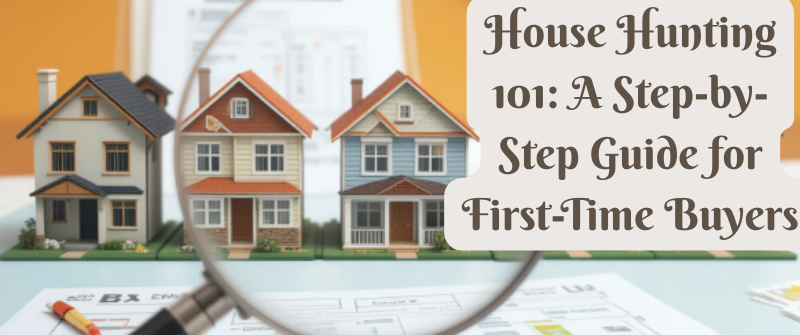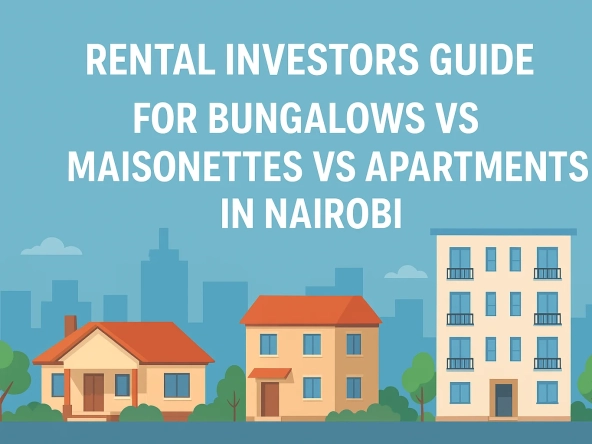Buying your first home is an exciting milestone, but searching for the right one can feel overwhelming. This guide breaks down the home-hunting journey into clear steps to make it easier, from setting a budget to evaluating potential homes.
Step 1: Assess Your Financial Situation

Before you start looking at houses, it’s crucial to determine what you can realistically afford.
This will help you focus on homes within your financial range and avoid disappointment later. Here’s what you need to do:
- Check Your Credit Score: Your credit score affects your mortgage approval and interest rates. A higher score can secure better loan terms. Use free online tools to check your score and take steps to improve it if necessary.
- Determine Your Budget: Consider not just the home price but also additional expenses such as property taxes, insurance, maintenance, and utilities. Online mortgage calculators can help you estimate monthly payments based on different loan scenarios.
- Understand Debt-to-Income Ratio: Lenders look at your monthly income compared to your debts to assess affordability. Keeping your debt-to-income ratio low increases your financial flexibility.
- Save for a Down Payment and Other Costs: While 20% down payments are standard, some loan programs allow lower down payments. However, a larger down payment reduces your monthly mortgage and interest costs. Also, prepare for additional expenses like closing costs, moving fees, and potential renovations.
Step 2: Determine Your Needs vs. Wants
Before you begin searching for a home, it’s essential to clarify what features you need and which ones are simply nice to have.
This helps narrow down your search and prevents you from getting sidetracked by appealing but unnecessary features.
Needs (Must-Have Features)
These are non-negotiable aspects that directly impact your daily life and convenience. Consider:
- Number of Bedrooms & Bathrooms: Think about your family size and potential future needs.
- Location: Proximity to work, schools, public transportation, and amenities like grocery stores or hospitals.
- Safety & Crime Rates: Research neighborhoods to ensure they meet your security expectations.
- Home Size & Layout: Make sure the space suits your lifestyle and plans.
Wants (Nice-to-Have Features)
These are features that would enhance your living experience but aren’t deal-breakers if missing. Examples include:
- Walk-in closets
- Modern kitchen upgrades
- Swimming pool or large backyard
- Finished basement or home office space
By defining these categories, you can filter out unsuitable homes more efficiently.
How to Know What You Want in a House

Finding the perfect home starts with knowing exactly what you need and want.
Many homebuyers struggle with indecision because they haven’t clearly defined their priorities.
Here’s a step-by-step guide to help you determine what you truly want in a house before you start your search.
1. Evaluate Your Current Living Situation
Start by analyzing your current home to understand what works and what doesn’t. Ask yourself:
- What do you like most about where you live?
- What are your biggest frustrations or limitations?
- Do you need more space, a better location, or specific features?
- How has your lifestyle changed since you moved in, and how might it change in the next few years?
Taking note of these factors helps you clarify what you should prioritize in your next home.
2. Consider Your Future Plans
Think about how long you plan to stay in the home and whether it will accommodate future changes in your lifestyle, such as:
- Growing family needs (additional bedrooms, play areas).
- Remote work requirements (home office space, quiet environment).
- Retirement plans (single-level home, minimal maintenance).
Planning ensures you won’t outgrow your home too quickly.
3. Research Neighborhoods Thoroughly
A home’s location can impact your quality of life significantly. Factors to consider include:
- Commute times and access to public transportation.
- School district ratings, if you have or plan to have children.
- Proximity to grocery stores, restaurants, hospitals, and entertainment.
- Noise levels and overall neighborhood vibe.
Visit potential neighborhoods at different times of the day to get a realistic feel for traffic, safety, and activity levels.
4. Determine Your Preferred Home Style
Do you prefer a modern, contemporary home or something more traditional? Consider:
- Architectural style (ranch, colonial, craftsman, etc.).
- Interior layout (open floor plan vs. separate rooms).
- Aesthetic preferences (minimalist, rustic, industrial, etc.).
Your home should reflect your personality and lifestyle preferences.
5. Test Out Home Features Before Deciding
Sometimes, what looks good on paper may not work in real life. Before making a final decision:
- Walk through different home styles at open houses.
- Imagine yourself living in the space.
- Test things like closet space, kitchen functionality, and bathroom layouts.
- Consider renting in a similar neighborhood or home type if unsure.
Step 3. Make a Home Search Checklist

Once you’ve defined your needs and wants, create a checklist to help you stay focused during house hunting. This can include:
- Ideal home size and layout
- Preferred neighborhoods
- Key must-have features
- Budget limits
- Deal-breakers (things you absolutely won’t accept)
This checklist will help streamline your search and keep you from being overwhelmed by too many options.
Step 4: Get Pre-Approved for a Mortgage
A pre-approval letter from a lender shows sellers that you’re a serious buyer and can afford a home within a specific price range. It also helps you stay within budget.
- Compare Different Lenders: Shop around for mortgage lenders and compare interest rates, loan terms, and fees.
- Prepare Necessary Documents: Lenders typically require tax returns, bank statements, pay stubs, and proof of assets.
- Understand Different Loan Options: Research fixed-rate vs. adjustable-rate mortgages, as well as government-backed loans like FHA, VA, or USDA loans if you qualify.
- Stay Financially Stable: Avoid large purchases or taking on new debt during this period, as it could impact your loan approval.
Step 5: Work with a Real Estate Agent
A good real estate agent can streamline your search process and provide valuable insights. Here’s how to find the right one:
- Research and Interview Agents: Look for licensed agents with experience in your target area. Check online reviews and ask for referrals from friends or family.
- Ask About Their Experience & Approach: A knowledgeable agent should understand local market trends and guide you through negotiations.
- Communicate Your Preferences Clearly: Provide details on your budget, must-have features, and preferred neighborhoods so they can find the best matches for you.
- Understand Their Commission: Agents typically earn a commission from the home sale, but it’s usually covered by the seller.
Step 6: Start Your Home Search
Once you have a clear vision of what you’re looking for and a budget in place, it’s time to actively search for properties.

- Use Online Listings: Websites like Zillow, Realtor.com, Redfin, and MLS listings allow you to browse homes based on price, location, and features.
- Set Up Alerts: Many real estate sites let you set up notifications for new listings that match your criteria, helping you act quickly on potential homes.
- Drive Through Target Neighborhoods: Some great listings may not always be online. Exploring neighborhoods can help you discover hidden gems.
- Check Market Trends: Research the local housing market to determine whether prices are rising or if it’s a buyer’s market with room for negotiation.
Step 7: Attend Open Houses & Schedule Private Showings
Visiting homes in person is crucial to understanding what works for you. Here’s how to make the most of your visits:
- Attend Open Houses: These allow you to explore multiple homes in a single day and compare options.
- Schedule Private Showings: If a home interests you, arrange a more in-depth viewing with your real estate agent.
- Take Notes & Pictures: After seeing multiple homes, it’s easy to forget details. Keep track of pros and cons for each property.
- Ask Important Questions: Find out about recent renovations, property taxes, HOA fees, and any potential upcoming maintenance.
Step 8: Evaluate Homes Carefully

Beyond surface-level aesthetics, take a detailed look at each property’s condition and long-term suitability.
Things to Check Inside the Home:
- Structural Integrity: Look for cracks in walls, uneven floors, and potential water damage.
- Plumbing & Electrical Systems: Check faucets, water pressure, and electrical outlets for functionality.
- Storage & Space: Ensure there’s enough closet and storage space for your needs.
- Noise Levels: Pay attention to street noise or thin walls that could affect daily comfort.
Things to Check Outside the Home:
- Roof & Gutters: Look for missing shingles or signs of leaks.
- Landscaping & Drainage: Poor drainage can cause foundation problems.
- Parking & Driveway: Ensure there’s enough space for your vehicles.
Neighborhood Evaluation:
- Safety & Crime Rates: Check local crime reports and visit the area at different times of the day.
- Traffic & Commute: Test out the commute to work or school during rush hours.
- Future Development Plans: Research upcoming projects that might affect home value.
By carefully evaluating each home and its surroundings, you’ll be better prepared to make an informed decision when the right opportunity comes along.
By following these steps, you’ll be well-equipped to navigate the house-hunting process with confidence. With a clear understanding of your budget, priorities, and evaluation criteria, you’ll be on your way to finding the perfect home!
Conclusion
Knowing what you want in a house makes tAhe home-buying process smoother and more enjoyable. By identifying your must-haves, understanding your future needs, and setting a budget, you’ll be well-prepared to find a home that truly suits you.
Take your time, do thorough research, and trust your instincts—your perfect home is out there waiting for you!



